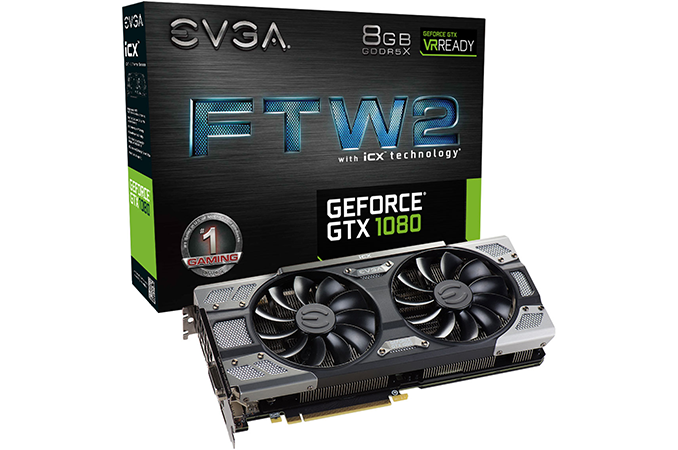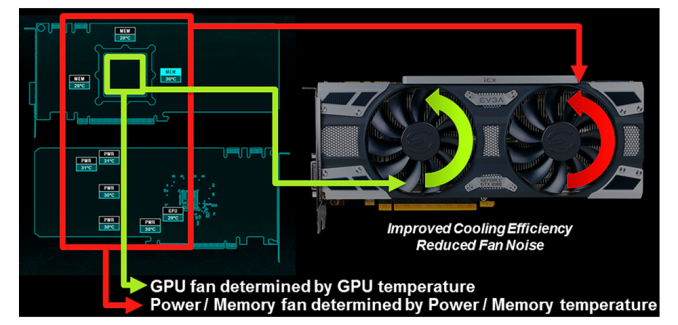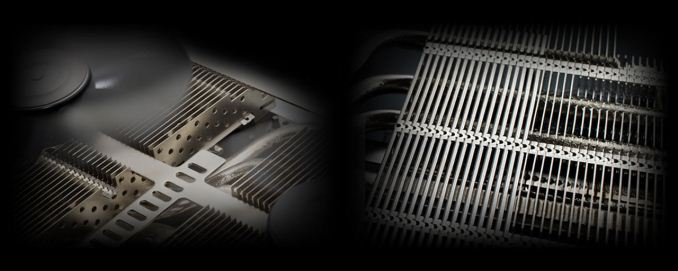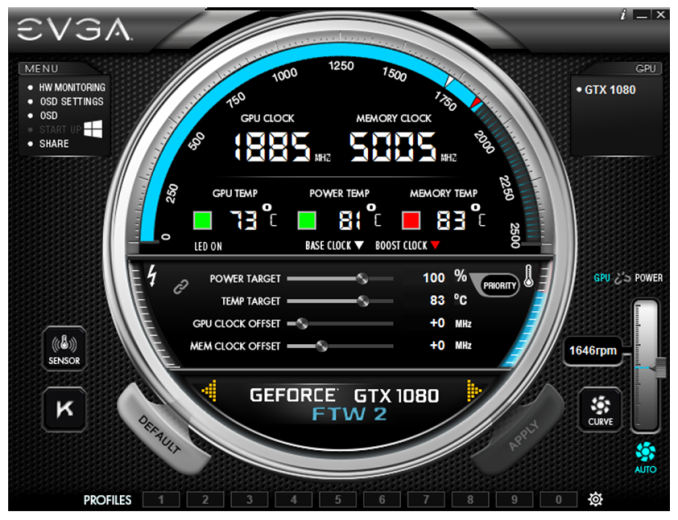EVGA's New iCX Range: NVIDIA GPUs with More Control for Cooling
by Anton Shilov on February 15, 2017 11:00 AM EST
EVGA has introduced a new iCX cooling and tuning technology for its GPUs that promises higher efficiency and better control compared to predecessors. The video cards feature multiple onboard thermal sensors and microcontrollers (MCUs) designed that enable users to precisely tune settings of their cards and monitor their state for potentially better performance, stability, and endurance.
Modern high-end graphics adapters have three heat sources: the GPU silicon itself, the memory chips, and the VRM circuitry. To overclock a video card successfully, one needs to ensure that none of these components overheats under the higher voltage. While modern GPU silicon has built-in temperature sensors, memory chips do not (GDDR5X chips have integrated temperature sensors, rare GDDR5 ICs do too) and VRM temperature cannot be monitored without using special tools as well. Motherboard manufacturers usually add onboard sensors for monitoring, and here EVGA is doing the same. Squeezing all the overclocking headroom from a graphics card may be complicated since it is not easy to determine which component is overheating due to the high load, and a typical response is to increase cooling to the whole card (which means increasing the speed of all the fans creating excessive noise). EVGA's new cooler design is meant to offer more control over what needs to be cooled.
EVGA’s iCX technology uses nine thermal sensors on the graphics card to monitor GPU, VRM and memory temperatures and then its Precision XOC software can make decisions regarding cooling the components that actually require it. In a bid to cool-down VRM, the application increases the speed of the fan on the right-hand-side of the card, whereas when the GPU and memory need some extra cooling, the board speeds up the left fan. Fan speeds are regulated independently with their own temperature/power curves and therefore do not produce excessive noise unless needed. Alternatively, users can manually regulate GPU and memory frequencies as well as fan speeds using the Precision XOC software, and the fans will react accordingly. The app allows to set power and temperature targets and even create profiles for different occasions.
In addition to the new PCB design and the Precision XOC software, the iCX package includes a new cooling system with redesigned heatsinks (which EVGA calls “purposefully-directed airflow chambers”). The latter now have small holes in their fins to make it easier for the air to pass through them. The heatsink fins are L-shaped to increase surface contact, and some fins are half open to maximize airflow. Finally, the cooler has a special thermal LED display system that reflects a combination value of the temperature of the GPU, memory and VRM, and can act as a visual aid to warn users of overheating (if the software does not do it for some reason).
EVGA will use its iCX cooling initially on variants of NVIDIA cards that feature its proprietary PCBs (e.g., FTW2, SC2, etc.), just like it uses the ACX-series coolers today. The initial family (see the tables for details) of add-in-boards with iCX includes three GTX 1080 parts, three GTX 1070 parts, and four GTX 1060 6GB/3GB cards.
| EVGA GeForce GTX 1080 with iCX Technology | |||||||
| GTX 1080 GAMING iCX | GTX 1080 SC2 GAMING iCX | GTX 1080 FTW2 GAMING iCX | |||||
| 08G-P4-6581-KR | 08G-P4-6583-KR | 08G-P4-6686-KR | |||||
| Stream Processors | 2560 | ||||||
| Texture Units | 160 | ||||||
| ROPs | 64 | ||||||
| Core Clock (MHz) | 1607 | 1708 | 1721 | ||||
| Boost Clock (MHz) | 1733 | 1847 | 1860 | ||||
| Memory | Capacity | 8 GB | |||||
| Type | GDDR5X | ||||||
| Clock | 10 Gbps | ||||||
| TDP | 180 W | 180 W | 215 W | ||||
| Launch Date | Q1 2017 | ||||||
| Launch Price | $639.99 | $649.99 | $679.99 | ||||
As usual, some of EVGA’s AIBs come factory overclocked and may have an increased TDP when compared to NVIDIA's reference designs. Due to different frequencies and TDPs, all the cards have different PCB designs and different VRMs, but the key components of the iCX (sensors, MCUs, two fans, safety fuse, etc.) are present on all iCX cards.
EVGA currently sells two graphics cards with its iCX cooling and tuning technology: the EVGA GeForce GTX
1080 SC2 GAMING iCX ($649.99) and the EVGA GeForce GTX 1070 SC2 GAMING iCX ($449.99). Those interested in other members of the new lineup may sign up for notification about their availability. Given that EVGA has already announced all the cards, they should hit the market in the coming weeks, but we are not sure whether all the remaining SKUs are going to arrive at the same time.
| EVGA GeForce GTX 1070 with iCX Technology | |||||||
| GTX 1070 GAMING iCX | GTX 1070 SC2 GAMING iCX | GTX 1070 FTW2 GAMING iCX | |||||
| 08G-P4-6571-KR | 08G-P4-6573-KR | 08G-P4-6676-KR | |||||
| Stream Processors | 1920 | ||||||
| Texture Units | 120 | ||||||
| ROPs | 64 | ||||||
| Core Clock (MHz) | 1506 | 1594 | 1607 | ||||
| Boost Clock (MHz) | 1683 | 1784 | 1797 | ||||
| Memory | Capacity | 8 GB | |||||
| Type | GDDR5 | ||||||
| Clock | 8 Gbps | ||||||
| TDP | 150 W | 170 W | 215 W | ||||
| Launch Date | Q1 2017 | ||||||
| Launch Price | $439.99 | $449.99 | $469.99 | ||||
As for pricing, the addition EVGA’s iCX cooling will come at a small premium. The cheapest EVGA GeForce GTX 1080 with iCX will be priced at $639.99 ($40 above NVIDIA’s MSRP), whereas the lowest-cost EVGA GeForce GTX 1070 with iCX will be sold for $439.99 ($60 above MSRP). Prices for EVGA’s GeForce GTX 1060 boards with iCX were given at this time.
| EVGA GeForce GTX 1060 with iCX Technology | ||||||||
| GTX 1060 6GB SSC2 GAMING iCX |
GTX 1060 6GB FTW2+ GAMING iCX |
GTX 1060 3GB SSC2 GAMING iCX |
GTX 1060 3GB FTW2+ GAMING iCX |
|||||
| 06G-P4-6667-KR | 06G-P4-6768-KR | 03G-P4-6567-KR | 03G-P4-6767-KR | |||||
| Stream Processors | 1280 | 1152 | ||||||
| Texture Units | 80 | 72 | ||||||
| ROPs | 48 | |||||||
| Core Clock (MHz) | 1607 | 1632 | 1607 | 1632 | ||||
| Boost Clock (MHz) | 1835 | 1860 | 1835 | 1860 | ||||
| Memory | Capacity | 6 GB | 3 GB | |||||
| Type | GDDR5 | |||||||
| Clock | 8 Gbps | |||||||
| TDP | 120 W | 150 W | ||||||
| Launch Date | 1H 2017 | |||||||
| Launch Price | TBD | TBD | TBD | TBD | ||||
Related Reading:
Source: EVGA














20 Comments
View All Comments
MrSpadge - Wednesday, February 15, 2017 - link
Overclock with a gpu clock offset and lower the power / temperature target to get about similar performance at lower power consumption / heat / stress / cost. Far more efficient than simply underclocking the GPU.BrokenCrayons - Thursday, February 16, 2017 - link
Meh effort, thinking...not worth it for a computer.Achaios - Wednesday, February 15, 2017 - link
EVGA just does it right everytime, except for their latest debacle.Willing to bet one month's pay that the clown responsible for the fiasco with ACX 3.0 has been fired, unless ofc it was the CEO himself who was "cutting c0rner$".
I've listened to JAYZ TWO CENTS' version of the whole affair, and as he is a known EVGA tool, I think that the order to "cut corners" on the ACX 3.0 1080's came from the upper echelons of EVGA, as the CEO, who met with JAYZ, told him "Jay, we screwed up".
Anyone who is experienced with upper echelons of management in corporations will tell you that when the CEO says "we screwed up" then the fail is most probably his, b/c if it was the fail of someone else down the food chain he would have said "my engineers screwed up" or the "superintendent engineer screwed up" or simply, "we are restructuring our tech department".
So, I am hoping the CEO of EVGA learned his lesson.
BrokenCrayons - Wednesday, February 15, 2017 - link
A good leader owns the failures of her people as her own and credits them individually for their successes. Maybe "we screwed up" means, "I'm accepting responsiblity for this problem and I won't assign blame publically to a particular department in my company."JoeyJoJo123 - Wednesday, February 15, 2017 - link
I think you failed to realize that ACX 3.0 was another revision to try to capture a larger audience by redesigning the appeal of the card's aesthetics. By comparison, ACX 2.0 cards looked very "vanilla" in a crowd of "gamer pleasing designs" (take that with a grain of salt, as I thought the ACX 2.0 was the best of the bunch, second only to the Nvidia OEM blower shroud, visually).The reason the VRMs got hot is because, technically, backplates actually restrict cooling performance to modules on the back of the GPU. Despite the aluminum shroud being metal, and therefore conductive of heat, the backplate just traps the heat between the card's PCB and the backplate.
The redesigned ACX 3.0 backplates have very little ventilation compared to the perforated ACX 2.0 backplates (which seldomly sold with the card, they were sold aftermarket for most ACX 2.0 GPUs for ~$20, this was a business decision justified by the engineering team knowing no backplate had better performance, not the marketing team trying to win customers over with a shiny backplate on each GPU).
Compare the perforation:
ACX 2.0 GTX 980 Ti: http://www.itrw-pc.com/wp-content/uploads/2015/10/...
ACX 3.0 GTX 1070: https://content.hwigroup.net/images/products_xl/35...
The problem with ACX 3.0 was that the marketing team led the decision of including backplates by default, thinking that any degraded performance shouldn't be detrimental to the health of the card, well, they were wrong. To alleviate the situation they needed to send an optional recall or for users who opt to keep their cards, instructions and thermal pads to better interface PCB chips on the back of the card to thermally transfer excess heat to the backplate. (Alternatively, you can just remove the backplate and all is OK, too.)
It's a classic case of function vs form. In ACX 2.0, function led over form. And in ACX 3.0's offering, they decided to go with form (aesthetics) over function, and as a result ACX 3.0 GPUs began encountering failures.
JoeyJoJo123 - Wednesday, February 15, 2017 - link
In other words, you're wrong to point the blame at the engineers. They clearly knew what they were doing with ACX 2.0. The engineers weren't making the final design decision though, and using them as a scapegoat for the failures of ACX 3.0 shows that you're failing to grasp the entire picture of what happened.blzd - Thursday, February 16, 2017 - link
Didn't the EVGA 900 series backplate have thermal pads as well? They should also help with graphics card sagging in the PCIe slot.JoeyJoJo123 - Friday, February 17, 2017 - link
Yes, GTX 900 series backplates which were sold separately did include thermal pads.The GTX 1000 series backplates which were included by default had little perforation and no thermal pads.
The inclusion/exclusion of thermal pads isn't necessarily important though. A GPU with backplate + thermal pads still, on average, performs a bit worse than or equal to a GPU with no backplate covering the backside VRMs.
So while the GTX 1000 EVGA cards got bad flak for killing GPUs, a viable solution that didn't require any RMA or anything back from EVGA was just removing the backplate, and that was it. 2 generations of GPUs ago, GPUs commonly sold _without_ backplates and didn't encounter VRM overheating issues. This was the norm.
The addition of cosmetic backplates have resulted in worse temperatures in general for components on the back of the GPU PCB.
SeeManRun - Wednesday, February 15, 2017 - link
I won't trade in due to the reduced speed. They downclocked the card to save heat by over 150 mhz. I will keep my card with the ACX 3.0 cooler and unmodified bios!Michael Bay - Wednesday, February 15, 2017 - link
Never trust EVGA with their cooling bullshit. I should know, I`ve bought their 980.